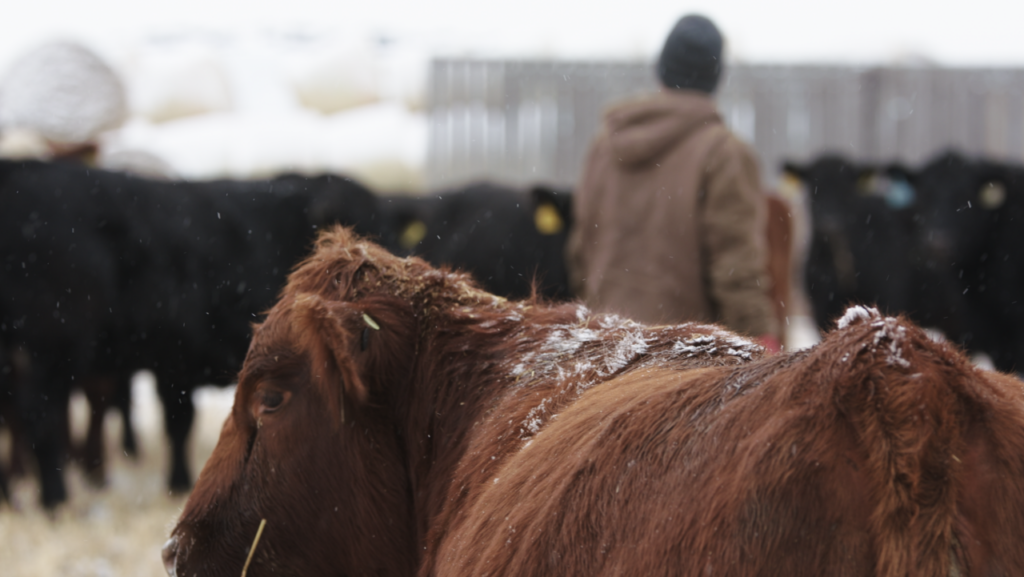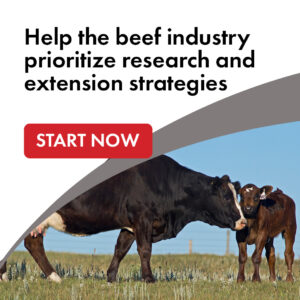An Ounce of Prevention 🎙️
This article written by Dr. Reynold Bergen, BCRC Science Director, originally appeared in the February 2024 issue of Canadian Cattlemen magazine and is reprinted on the www.BeefResearch.ca with permission of the publisher.
CLICK THE PLAY BUTTON TO LISTEN TO THIS POST:

Vaccines are an important tool to help minimize preweaning calf illness and death early in life, reduce the risk of reproductive failure in the breeding herd and help improve colostrum’s ability to protect next year’s calf crop when it hits the ground.
Vaccine technology, programs and practices are constantly evolving. All the options can be confusing, but more options can also make it easier to customize and combine those options in a way that optimally protect your herd against the diseases that are most important to you.
Dr. Cheryl Waldner and coworkers at the Western College of Veterinary Medicine studied vaccination practices from coast-to-coast in 2020 (“Vaccine use in Canadian cow-calf herds and opportunities for improvement”; DOI 10.3389/fvets.2023.1235942).
What They Did
Cow-calf producers from BC (6), Alberta (38), Saskatchewan (27), Manitoba (18), Ontario (20), New Brunswick (2) and Nova Scotia (2) were surveyed about which vaccines they used and when they were using them in different groups of cattle.
What They Learned
Vaccination rates have improved nationwide in recent years.
Breeding herd: Overall, nearly all producers gave cows (97%), replacement heifers (95%) and bulls (83%) at least one vaccination in 2020. 92% of producers vaccinated their cows and replacement heifers against IBR, BRSV, PI3 and BVD. These “core vaccines” help protect against viruses that contribute to reproductive failure and pneumonia. Vaccination against clostridial diseases (e.g., blackleg) was less common (~50% of herds), possibly because some producers elect to use those vaccines every other year. Vaccination rates were still lower for bulls; sometimes they’re overlooked, sometimes they’re simply less pleasant to deal with. Vaccination against footrot was most common in bulls (31% of herds), presumably because sore bulls on pasture are even less pleasant to deal with.
Nursing calves: Nearly all (99%) producers gave calves at least one vaccine in 2020. Core viral vaccines against IBR, BRSV and PI3 (all 92%) and BVD (78%) were used most frequently. Calves were also often vaccinated against clostridial diseases (87%). Vaccination against BRD bacteria (pasture pneumonia) was also relatively common (e.g., 56% of herds vaccinated against Mannheimia).

But booster vaccinations were given less often (e.g., 47% for IBR, BRSV and PI3, 30% for BVD, 26% for clostridial diseases and 4 to 27% for BRD bacteria). The booster shot recommended by the label is essential to get the most protection the vaccine can provide. Neglecting boosters is probably about logistics – producers give vaccines when the facilities, time and labor are all available at the same time.
Other lessons: Intranasal vaccines are becoming more popular, especially for newborn calves. Injectable vaccines are largely ineffective until the antibodies from the mother’s colostrum have waned, so they are not usually given before calves are a few months old. Intransal vaccines do not have this limitation – they provide protection even in newborn calves. But there are several things to be aware of. Intranasal vaccines provide protection earlier in life, but they may not last as long, so boosting with an injectable vaccine a few months later during spring processing is particularly important. Secondly, current intranasal vaccines cover three of the core viruses (IBR, BRSV and PI3) but not BVD. That means that the calf still needs an injectable BVD vaccination during spring processing (when the IBR, BRSV and PI3 are being boosted). Research to identify the optimal combinations and timings of various intranasal (“mucosal”) and injectable (“systemic”) vaccines for optimal immune protection is underway.
Vaccines against clostridial diseases like blackleg were used much more widely in Western than in Eastern Canada, even though these bacteria are a threat across the country. Western producers were also more likely to vaccinate their calves against BRD bacteria than Eastern producers. BRD (pneumonia) is not just a feedlot disease; it’s also the most common reason for antibiotic treatment of calves before weaning. Vaccinating all the calves at spring processing will help reduce the number of calves you need to chase, catch, tackle, stress and treat on summer pasture.
So What Does This Mean… To You?
Work with your veterinarian to make sure that your vaccination program includes all the core vaccines and other important diseases facing your herd (or neighborhood) and production system. They can look at the vaccines you’ve used recently and point out new alternatives that may be a better fit for your needs (e.g., killed vs. modified live). Make sure they understand your entire operation so that the vaccination and booster schedule fits with fieldwork, pasture turnout dates, community pastures, pregnancy checking, etc
Bottom Line: Vaccines can help your cattle resist common diseases, but they’re not a magic bullet. Vaccines won’t overcome poor management. Cattle can’t take full of advantage of the protection vaccines can offer if nutrition (e.g., protein, energy, vitamins, minerals) is lacking or disease pressures are too high (e.g. excessive mud, manure or overcrowding).
Speaking of surveys; we’d really appreciate it if you could take some time to participate in the Canadian Cow-Calf Survey. This survey will help the BCRC refine our research priorities and producer extension efforts. You can find it at BeefResearch.ca/survey.
The Beef Cattle Research Council is funded by the Canadian Beef Cattle Check-Off. The BCRC partners with Agriculture and Agri-Food Canada, provincial beef industry groups and governments to advance research and technology transfer supporting the Canadian beef industry’s vision to be recognized as a preferred supplier of healthy, high-quality beef, cattle and genetics. Learn more about the BCRC at www.beefresearch.ca.
Click here to subscribe to the BCRC Blog and receive email notifications when new content is posted.
The sharing or reprinting of BCRC Blog articles is typically welcome and encouraged, however this article requires permission of the original publisher.
We welcome your questions, comments and suggestions. Contact us directly or generate public discussion by posting your thoughts below.
